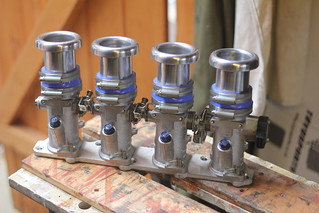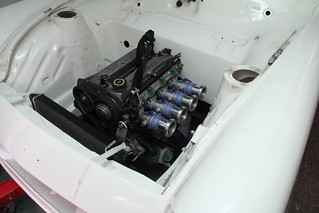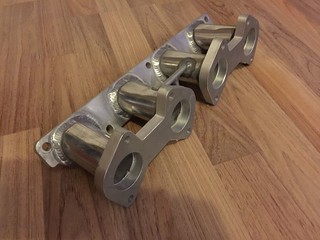Ugg10
|
| posted on 1/1/16 at 12:43 PM |

|
|
Throttle body choices ???
Warning long post for easy questions.
Ok, so I am getting to the point where I am about to start up my engine (Puma 1.7) for the first time (when I get the last few electrickery niggles
sorted) and have a decision on which inlet system to use.
My current system uses triumph 955 RS sprint throttle bodies mounted on a flat plate and bolted to the head. The ports are close but not matched
exactly, the throttle bodies are slightly smaller than the head inlet ports (which I suppose is the better way to have it from a flow point of view).


Based on my calculations -
Inlet port area is - 1285mm^2
Equivalent round tube diameter is - 40.4mm
triumph inlet end area is - 1385mm^2 (42mm diam)
triumph head end area is - 1195mm^2
Equivalent round tube diameter is - 39mm (so slightly tapered)


The current inlet length with the full radius trumpets is 290mm which is a bit short of the 350mm using this calculator with 3 harmonics -
http://www.velocity-of-sound.com/velocity_of_sound/calculator2.htm
I do have a bit of leeway if I push out the trumpets so that i have at least 1 diameter (45mm) from the inner arch.
Anyway, since bolting this set up in I have manage to snag a DCOE inlet manifold for the engine that has the right shaped ports and a set of TJ 42mm
parallel throttle bodies (similar to Jenveys, should arrive next week).


The manifold is 95mm long and although I don't have the TBs yet I am guessing they are around 100-110mm long with the butterfly half way along.
So the overall length of the manifold/TB will be around 200mm giving an inlet tract length of 310mm, I can then add the full radius trumpets to get
closer to the desired 350mm.

So (finally), I guess the questions are -
1) will the better fitting and slightly larger manifold/TBs be noticeable compared to the Triumph set up ?
2) with the change in butterfly position make much difference (75mm from head for triumph and approx 150mm for Manifold/TB, injectors will be OEM in
the head)?
3) will a change in inlet length from 290mm to say 335mm (leaving breathing space next to the inner wing) make a noticeable difference?
Thanks in advance for all comments.
---------------------------------------------------------------
1968 Ford Anglia 105e, 1.7 Zetec SE, Mk2 Escort Workd Cup front end, 5 link rear
Build Blog - http://Anglia1968.weebly.com
|
|
|
|
|
coozer
|
| posted on 1/1/16 at 02:45 PM |

|
|
Well, looks like you have it pretty sussed there. Only true way to answer your questions is on a rolling road really. And, it all depends on engine
spec as well for different results, is low down torque or high power/high revs what your looking for? Nice smooth daily drive or drag strip style
high revving monster??
It also depends how much room you have in the engine bay. For me I went for a setup that fit under the bonnet and I suspect a lot of other people do
the same.
1972 V8 Jago
1980 Z750
|
|
|
johnH20
|
| posted on 1/1/16 at 03:47 PM |

|
|
I have no answers to your specific questions, although I would be interested in the answers as I am working on a similar set up for my Cyclone.
Nevertheless, my reading around this subject, supported by comments on here, suggests that dedicated 'car' TBs have better part throttle
progression than 'bike' TBs used on a car engine. In practice this might be a more significant decision factor. Good luck and keep us
posted.
|
|
|
SPYDER
|
| posted on 1/1/16 at 05:22 PM |

|
|
quote:
Originally posted by johnH20
suggests that dedicated 'car' TBs have better part throttle progression than 'bike' TBs used on a car engine...
If you replace the tiny throttle quadrant on the bike TBs with a larger one and make it progressive this particular problem evaporates. That together
with not fitting oversized ones in the first place.
|
|
|
johnH20
|
| posted on 1/1/16 at 07:04 PM |

|
|
This is a top tip that is not widely known. Thanks
|
|
|
Ugg10
|
| posted on 1/1/16 at 08:42 PM |

|
|
Thanks guys, will mock up the tj tbs when I get them and see how they look, probably get it running on the triumph system but may take it off so I
can plumb in the coolant runs as it us a bit conjested on that side of the engine. The tj tbs and manifold are at a bit steeper angle so will give a
bit more room.
Agree with comment on throttle progression, just needs bigger quadrant or move the pivot on the accelerator pedal (smaller distance between pivot and
cable connection point = more pedal movement for same throttle movement).
Fir info engine is stock, in an anglia 105e (approx 750kg) and for road use so torque is probably better than outright power.
JohnH20, If you need more info on this engine for the cyclone search out the threads by jenko as he has one on gsxr tbs in his j15. His made 155hp
with a similar set up.
[Edited on 1/1/16 by Ugg10]
---------------------------------------------------------------
1968 Ford Anglia 105e, 1.7 Zetec SE, Mk2 Escort Workd Cup front end, 5 link rear
Build Blog - http://Anglia1968.weebly.com
|
|
|
Hornet
|
| posted on 2/1/16 at 12:15 PM |

|
|
Hi bud I have run the 1.7 for a few years, the standard 1.7 puts out 125 bhp . I first put racing puma cams in and 45mm jenveys with 4:2:1 exhaust.
With an emerald ecu I got 159 bhp. I then put LMS3 cams in and got this up to 169bhp. So what I'm saying is, you won't get much of a gain
with your inlet setup. You will need to look at uprated cams. Ps I also removed the vvt.
|
|
|
Ugg10
|
| posted on 2/1/16 at 01:59 PM |

|
|
quote:
Originally posted by Hornet
Hi bud I have run the 1.7 for a few years, the standard 1.7 puts out 125 bhp . I first put racing puma cams in and 45mm jenveys with 4:2:1 exhaust.
With an emerald ecu I got 159 bhp. I then put LMS3 cams in and got this up to 169bhp. So what I'm saying is, you won't get much of a gain
with your inlet setup. You will need to look at uprated cams. Ps I also removed the vvt.
Thanks for the info, how does the lms3 compare to the shawspeed ss4 or piper 270/285 cams, did you use HD springs aswell?
---------------------------------------------------------------
1968 Ford Anglia 105e, 1.7 Zetec SE, Mk2 Escort Workd Cup front end, 5 link rear
Build Blog - http://Anglia1968.weebly.com
|
|
|
johnH20
|
| posted on 2/1/16 at 02:19 PM |

|
|
Hi Hornet, that is very interesting. The FRP engine is rated as 155 bhp according to Ford literature. ( The FRP spec vs standard Puma consists of
cams, inlet manifold and exhaust. No head mods. ) Is your power output perhaps wheel hp? It is difficult to believe Jenvies and an Emerald are only
worth 4 bhp. Your basic point is valid though, the OP is likely to be cam limited.
|
|
|
Ugg10
|
| posted on 2/1/16 at 02:31 PM |

|
|
Got to agree, I have seen a couple of RR results (wheel hp) for stock engine and stock cams but with tbs (typically 42mm) and exhaust and all make
about 155hp, chestersports cars zetec SE bike carb on a stock 1.6 gives 143hp (up from 100hp), and the addudtion of frp/ss4 typically make 175-180hp.
The cam swap is usually done with HD valve springs and arp rid bolts which allows the Rev limit to be raised to 8k.
[Edited on 2/1/16 by Ugg10]
---------------------------------------------------------------
1968 Ford Anglia 105e, 1.7 Zetec SE, Mk2 Escort Workd Cup front end, 5 link rear
Build Blog - http://Anglia1968.weebly.com
|
|
|
Hornet
|
| posted on 2/1/16 at 05:30 PM |

|
|
Hi Guys
The difference between standard and FRP is correct apart from it has a different intake manifold and a different ECU programme which has better
fueling and higher Revs, from memory 7500rpm vs 6000rpm. My LMS cams had roughly 1mm more lift than the FRP ones. I also advanced the intake by 4
degrees and the exhaust by 3degrees. The engines a great and rev like mad, but if you want +170bhp then you will need to spend serious money. I may
have lost a few bhp due to removing vvt but my ECU couldn't control it and there is mixed results with just switching it on at say 2500rpm. I
have some decent graphs with various power runs at different settings.
The ss4 are more aggressive than the LMS3 cams but as you know, what you get in top end you lose at the bottom. I use mines for sprint and road so
like the driveability they gave. I used normal springs. PS I also ported and polished the head.
|
|
|
Ugg10
|
| posted on 2/1/16 at 05:49 PM |

|
|
Thanks again for the info, all adds to the picture.
Here is a link to jenko's dyno tuning session http://paulsj15.blogspot.co.uk/2014/06/more-on-vct-system.html
His engine is stock other than gsxr tbs and decent exhaust. He found big top end gains switching off the vct over 5800rpm so with the omex using the
Alt output the approx method is to turn on vct between 2000 and 5800rpm and for a bit of economy off under 30% load.
---------------------------------------------------------------
1968 Ford Anglia 105e, 1.7 Zetec SE, Mk2 Escort Workd Cup front end, 5 link rear
Build Blog - http://Anglia1968.weebly.com
|
|
|
johnH20
|
| posted on 2/1/16 at 06:58 PM |

|
|
The link to the graphs above is a very good illustration of the effect of VCT. ( Note VCT and VVT tend to be use interchangeably but they are
different things entirely. VCT merely modifies fixed cam events by advancing or retarding them, VVT modifies the relative valve opening events and
usually the lift as well. ) VCT is basically a low/mid speed torque enhancing device which given full ECU control can also have fuel economy and
emissions advantages in the OEM environment.
So deleting VCT has no peak power effect on a Puma engine but it will compromise mid range torque. On the other hand optimising fixed valve events
with or without VCT is an entirely valid experiment with potential gains. Whether this matters for our lightweight performance orientated cars is a
fair point for discussion. Not sure this is directly relevant to the OP but posted for info
|
|
|
Jenko
|
| posted on 1/2/16 at 04:42 PM |

|
|
I read a fair amount about the delete VCT, and know the ST170 boys do this also, but apart from adding additional complication. I can't really
see why you would delete it. Agree with Hornet about the top end, but the amount of gain you get in the mid range is substantial, the in gear poke is
vastly improved. On my car the switch in / out is noticeable, but only if you are really thinking about it and looking for it....it's not harsh
in anyway (partly I would imagine to do with the professional set up).
The engine in my J15 still continues to be an absolute corker, and I love the fact that it's standard, and a blow up wold cost £100 to put right
:-)
MY BLOG - http://westfieldv8.blogspot.co.uk/
|
|
|
Ugg10
|
| posted on 1/2/16 at 05:34 PM |

|
|
With you on that Jenko, keeping it internally standard, externals can be easily switched over if it goes bank.
Got the car running on the Triumph TBs a couple of weeks ago but no coolant so just a start up -
https://www.youtube.com/watch?v=iI4fCBpX37Q&feature=youtu.be
Since then have removed them and put on the DCOE ones and have almost completed the plumbing so hopefully can give it a good run and check out the
cooling / set idle / balance TBs etc.

[Edited on 1/2/16 by Ugg10]
---------------------------------------------------------------
1968 Ford Anglia 105e, 1.7 Zetec SE, Mk2 Escort Workd Cup front end, 5 link rear
Build Blog - http://Anglia1968.weebly.com
|
|
|
cr500dom
|
| posted on 2/2/16 at 12:51 PM |

|
|
The sigma engine does like a long intake tract length and there is no gain to going bigger than 42mm throttle bodies even over 200Hp.
So get the biggest trumpets in there that you can 
EDIT (Nice install by the way  ) )
[Edited on 2/2/16 by cr500dom]
|
|
|
Jenko
|
| posted on 2/2/16 at 12:58 PM |

|
|
Would agree with that.......
I always read with interest about the inlet manifold and chamber on the ford racing puma. It's seems to have some mystical magic bhp producing
properties....Reality is is just improved over the standard offering and has some nice trumpets in it.
MY BLOG - http://westfieldv8.blogspot.co.uk/
|
|
|
Ugg10
|
| posted on 2/2/16 at 01:46 PM |

|
|
Cheers guys, hopefully with the 70mm long trumpets on the throttle bodies I should be at about 375mm inlet tract length and approx 42mm diam although
not totally smooth across the joins so some small losses there.
Using this - http://www.velocity-of-sound.com/velocity_of_sound/calculator2.htm
with 6800 rpm, 260 deg duration, 3 waves and 42mm you get 375mm inlet tract length so not far off - which is good.

[Edited on 2/2/16 by Ugg10]
---------------------------------------------------------------
1968 Ford Anglia 105e, 1.7 Zetec SE, Mk2 Escort Workd Cup front end, 5 link rear
Build Blog - http://Anglia1968.weebly.com
|
|
|
Jenko
|
| posted on 2/2/16 at 02:35 PM |

|
|
I think my inlet is shorter, and still sees 156bhp....so you should be good with that.
MY BLOG - http://westfieldv8.blogspot.co.uk/
|
|
|













